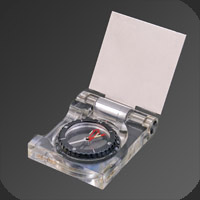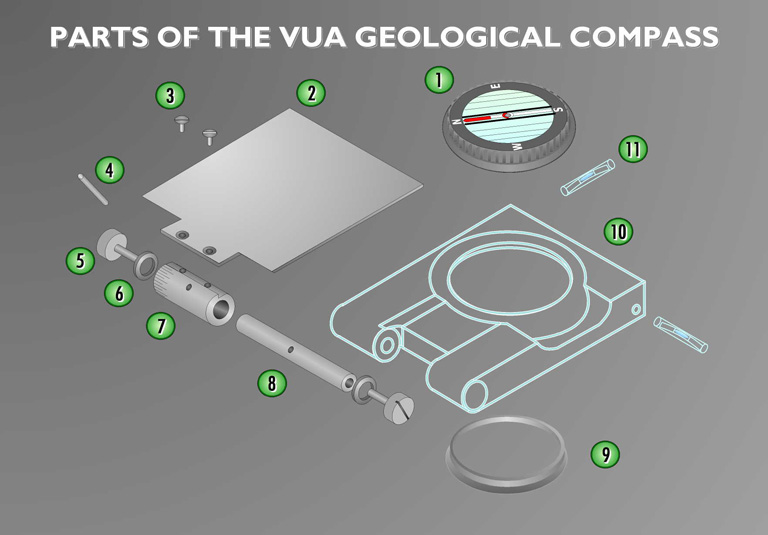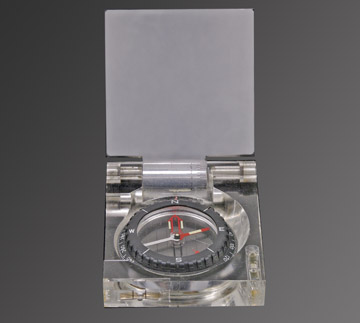
| The VUA geological compass : The compass |
| introduction |
| history |
| the compass |
| pictures |
| drawings |
| acknowledgments |
| disclaimer |
| contact |

|
Geological VNU compass top view diagonally behind |
|
|
The VUA compass presented here has been designed by Dr. László Westra, in those days senior lecturer at Vrije Universiteit, and Mr. Theo Hamer, who is also responsible for all technical details as the director of the instrument workshop attached to the Institute of Earth Sciences at the VUA at that time.
Geologists are interested in planar and linear structures of various sorts in rocks. A geological compass measures the geographic orientation of these planes and lines in space. Planes are defined (1) by the angle of a horizontal line (the strike) in the plane with the magnetic north (to be corrected to the true north) and (2) by the inclination or dip or plunge, which is the minimum angle between the plane and the horizontal. ( This would be in a vertical section. ) A line is being fixed (1) by the strike of the vertical plane through the line and (2) by the pitch or plunge which is the angle between the line and the horizontal line in the vertical reference plane.
|
|

The geological VNU compass frontview |
In practice, most geological compasses use the lid to identify the strike of planes and lineations. , and a separate inclinometer (yes or not build into the compass) for measuring the dip. The Clar type compasses such as the VU compass use the lid, as it were as a inclinometer with a scale engraved to the side. VUA compass has the scale more to the centre of the hinge construction.
A limited number of about 20 of the compasses have been produced by Theo Hamer and co-workers at VUA Earth Sciences workshop. Almost all of them have been offered to MSc and PhD students at graduation as a farewell surprise gift. At this moment (January 2021) the 4 specimens we know of, are after 30-40 years still in use and in perfect condition. |
|
The Free University compass has a rugged robust construction made of perspex (the house), dural (the lid) and stainless steel (optional lid), and is combined with a liquid filled compass readily available on the market (Silva, Suunto). This liquid filled compass has the advantage of the magnetic needle being
liquid damped and hence more stable than an air damped magnetic needle. In addition, the liquid absorbs shocks and hence reduces wear and tear a compass is exposed to from working in physically challenging terranes.
The liquid damped needle also has advantages in working at high latitudes with steep magnetic inclinations where air damped needles have a tendency to bend down and get more easily stuck to the bottom of the compass. The hinge inclinometer with a measuring range of 270 o graduated in 5 degree intervals allows acquiring dip and dip direction/strike and/or plunge and trend of a lineation in one efficient measurement without using the cumbersome pitch method. The hinge inclinometer with a measuring range of 270 ° graduated in 5 degree intervals allows acquiring dip and dip direction/strike and/or plunge and trend of a lineation in one efficient measurement without using the cumbersome pitch method. In the final phase of development, a turntable, which can be mounted in the lid of the instrument, was added as an option for direct, simultaneous in plane measurement of lineations. This device has been suggested by Dr. Harm Rondeel (Geological Institute, University of Amsterdam). To our experience the turntable is useful for the study of sedimentary rocks, less so for structural analysis. The VUA compass is constructed in such a way as to be easy to disassemble into its composing parts. Parts can be replaced. For example, a Silva or Suunto liquid filled orientation compass situated in the centre of the instrument, can be replaced by a new one in a matter of minutes. Similarly, the lids with or without a turntable can be readily exchanged with a screwdriver. Any individual who has access to, and the skill to handle a turn and milling bench, should be able to build this compass. In summary: The VUA compass is essentially a Clar-type geological compass consisting of a liquid filled compass such as Silva or Suunto, in a perspex housing, stainless steel and dural hinge and lid compounds. The compass has various fabrication options : e.g. it can be fitted out with either a solid dural (preferably) lid or a stainless steel lid with a perspex turntable. The compass is adequate for professional use, strong and durable. Easy to construct and cheap, and therefore suitable for geologists in developing countries. |
|